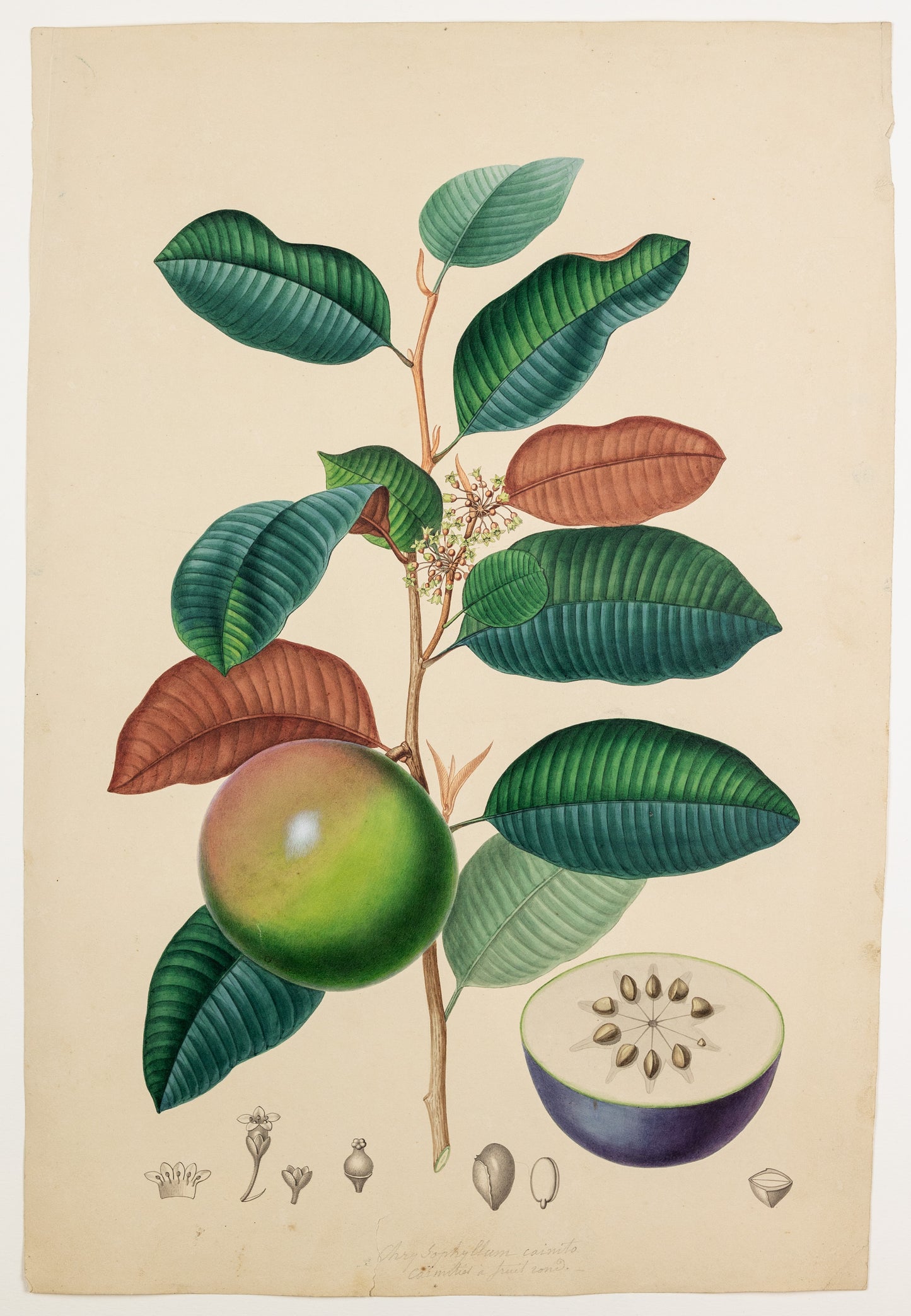from: Poiteau & Turpin Superb Botanical Drawings including varieties from the West Indies
PIERRE JEAN FRANÇOIS TURPIN (FRENCH, 1775 - 1840). Star Apple. 1808-1827.
PIERRE JEAN FRANÇOIS TURPIN (FRENCH, 1775 - 1840). Star Apple. 1808-1827.
Couldn't load pickup availability
PIERRE JEAN FRANÇOIS TURPIN (FRENCH, 1775 - 1840)
“Chrysophyllum cainito casmites (?) a fruit rond (Cainito Pomiferum. Chrysophyllum Cainito or the Star Apple)”
Preparatory drawing for F.R. Tussac. Flore des Antilles, ou histoire générale botanique, rurale et economique des végétaux indigènes des Antilles.
Paris: chez l’auteur, F. Schoell et Hautel, 1808-1827 Vol. 3, Pl. 9
Watercolor and pencil on paper
Inscribed “Chrysophyllum cainito casmites (?) a fruit rond”
Paper size: 18 3/4 x 12 in.
Frame size: 23 3/4 x 20 1/2 in.
The star apple originated in the Isthmus of Panama, where it was first cultivated. It has since spread to the Greater Antilles and the West Indies, and is now grown in various tropical regions, including Southeast Asia.
(continued>)
The fruit is commonly consumed as a fresh dessert and has a sweet taste that is best enjoyed when served chilled.
The star apple fruit comes in three different colors: dark purple, greenish brown, and yellow. The purple fruit has a thicker skin and texture, while the greenish brown variety has a thinner skin and a more liquid pulp. The yellow type is less common.
Tussac wrote of this tree:
“It is with good reason that the famous botanist Jacquin designates the cainito as one of the trees which must most attract the attention of travelers in the forests of the Antilles, by its beautiful stature, by its ample crown, whose foliage, it receives the winds, sometimes offers to the eyes the most cheerful greenery, the best suited to flatter this tree; sometimes, by presenting the underside of its leaves, covered with a down colored gold or silver, recalls the trees made with these two precious metals … The flowers of this tree add nothing to its beauty, they are very small and colorless; but they are followed by fruits of different sizes and colors, depending on the species or varieties, which add a lot to the amenities of these interesting trees. The fruit, the history of which I give here, is the size of a beautiful apple; its skin, very thin, is green on one side, and tinged with red on the other; there is a completely purple variety; these fruits, which we call cainitos, are served on the best tables; we must pay attention to the degree of maturity necessary to eat them, because before this time, the pulp is filled with a white, viscous juice, very unpleasant to taste … It is soft and sweet; we eat it with a small spoon. There are species of cainitos the size of European plums, purple in color above and inside. Others have the shape and almost the size of an olive. The wood of different species of this tree is used for different economic uses; it is quite hard and easy to work with. This tree multiplies easily by its seeds, which you must be careful to sow in the shade, as well as all tree seeds from the West Indies; except, however, in the mountains, where the sun does not burn the youngest plants as in the plains. At three years old, they can be transplanted, taking care to remove as much soil as possible around the roots, because in the Torrid Zones, the roots dry out very quickly if they are bare.”

Appeared in F.R. Tussac. Flore des Antilles, ou histoire générale botanique, rurale et economique des végétaux indigènes des Antilles.
Paris: chez l’auteur, F. Schoell et Hautel, 1808-1827 Vol. 3, Pl. 9


